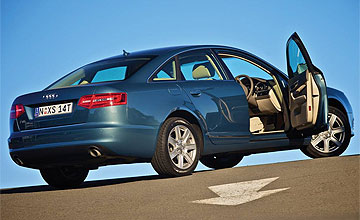BY CHRIS HARRIS | 20th Jul 2009

Opening the range at $74,500 and marketed under the “progressive performance” banner in Australia, the 2.0-litre TDI and 2.7-litre V6 TDI have been released in time to take a little of the limelight away from the all-new Mercedes-Benz E-class range also introduced this month.
Economy and affordability are the hallmarks of the diesel-powered newcomers, stretching the A6 series further down in price while offering luxury car tax benefits for buyers.
They also extend the number of Audi models under the LCT threshold of 7.0-litres per 100km to 21. This compares to just eight and seven models respectively (according to Audi’s figures) from BMW and Mercedes-Benz.
Also found in the just-released TT TDI quattro as well as a host of other Audi, Volkswagen and Skoda models sold in Australia, the 2.0-litre TDI is a 1968cc common-rail 1800-bar direct-injection pressure twin-cam unit with two balancing shafts, a variable-vane turbocharger and a particulate filter that helps deliver 125kW of power at 4200rpm and 350Nm of torque from 1750 to 2500rpm.
Driving the front wheels only via a seven-step continuously variable transmission and an electronically controlled multi-clutch plate set-up Audi dubs Multitronic, it sprints to 100km/h in 8.9 seconds, on the say to a 218k/h top speed.
On the other hand, the 2.0 TDI can return a combined fuel consumption figure of 5.8L/100km and a carbon dioxide emissions rating of 153 grams per kilometre.
Meanwhile, $10,000 more buys you the 2.7-litre V6 TDI, another common-rail 1800-bar direct injection pressure twin-cam unit with a variable-vane turbocharger.
A smaller version of the 176kW/500Nm 3.0-litre V6 TDI found in the $108,500 3.0 TDI quattro, this 2698cc unit (also found in the A4 2.7 TDI) produces 140kW between 3500 and 4400rpm and 380Nm from 1400 to 3500rpm.
However, unlike its bigger brother’s sequential shift automatic and quattro all-wheel drive specification, the 2.7 V6 TDI uses Multitronic to drive the front wheels only.
It hits 100km/h from standstill in 7.9 seconds and can achieve 227km/h, as well as 6.4L/100km and 169g/km of CO2 emissions.
As with the rest of the MY09-series A6 Series II range, the 2.0 TDI and 2.7 TDI are sedan-only models, offering substantial improvements to the suspension and steering system compared to its five-year-old C6 A6 Series 1 predecessor.
To recap, in February Audi launched the facelift with changes to the grille, headlights, fog lights, indicators and bumpers.
Cabin modifications ran to fresh trim, a redesigned back seat and restyled head restraints and more standard features such as satellite navigation, as well as range of new options that include adaptive lighting and lane-assist warning technology.
The addition of the new diesels, as well as efficiency drives in the V6 and V8 petrol engines, means that the latest A6 sees a range-wide fuel consumption average fall of between 12 to 15 per cent, according to Audi.
Diesels should account for about 45 per cent of all A6 sales, with the 2.0 TDI and 2.7 TDI gunning for the BMW 520d – which is the Bavarian company’s bestseller in the series – with 10 per cent each. The 2.0 TFSI petrol and 3.0 TDI are each prepped for 25 per cent of total A6 sales, while the 2.8 FSI and 3.0 TFSI petrol duo are slated for 10 and 20 per cent of the sales cake respectively.
In Europe, the A6 outsold all its rivals last year.